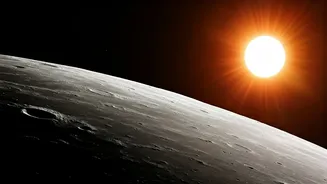Historic Observation Unveiled
India's Chandrayaan-2 lunar orbiter has achieved a remarkable feat by becoming the first to observe the effects of the Sun's Coronal Mass Ejections (CMEs)
on the Moon. This significant scientific discovery was announced by the Indian Space Research Organisation (ISRO). The observation utilized the Chandra's Atmospheric Composition Explorer-2 (CHACE-2) instrument, a scientific tool onboard the orbiter. The findings showed a notable surge in the total pressure of the Moon’s dayside exosphere, or its extremely thin atmosphere, when CMEs struck the lunar surface. ISRO reported that the number of neutral atoms and molecules increased significantly during this event. This confirmed long-standing theoretical models that had anticipated such an effect but had never before been directly observed.
CME's Impact on Moon
The research highlights how these solar emissions influence lunar atmospheres and surfaces. Unlike Earth, which has a magnetic field to shield it, the Moon lacks a global magnetic field and atmosphere, making it vulnerable to solar activity. This rare observation occurred on May 10 last year when multiple CMEs were emitted from the Sun toward the Moon. This activity caused atoms on the lunar surface to be released into the Moon's exosphere, temporarily increasing its density and pressure. According to ISRO, this observation provides valuable insights into how solar activity affects the lunar environment, which could be critical for planning future lunar habitats and scientific bases.
Chandrayaan-2 Mission Overview
The Chandrayaan-2 mission, launched on July 22, 2019, from Sriharikota, was India’s second lunar exploration endeavor. The mission was launched using the GSLV-MkIII-M1 rocket. It contained eight scientific instruments to investigate the Moon's surface, atmosphere, and mineral composition. While the Vikram lander faced communication issues during its landing attempt on September 7, 2019, the Orbiter remains fully operational. It continues to orbit the Moon at approximately 100 km altitude. The Orbiter has been providing valuable scientific observations for more than five years. The CHACE-2 payload, part of the orbiter's suite of instruments, is designed to study the composition and variability of the lunar exosphere. This unique observation not only improves our understanding of space weather and its effects on the Moon but also has implications for future lunar missions.

















